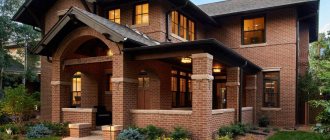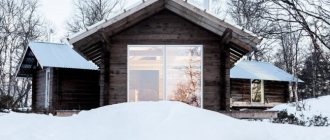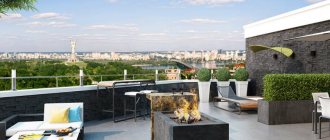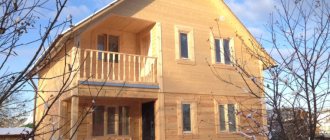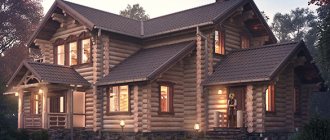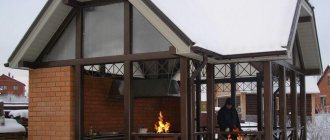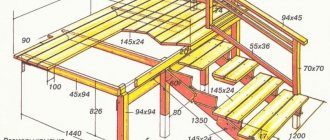Review author: Terrari School of Design
For those who are ready to surround themselves with the luxury of advanced technologies and are not afraid to give up “plush” comfort, the high-tech style is perfect.
This seemingly impossible combination of artificial materials, cool colors, advanced ideas and coziness can create a comfortable room filled with spacious comfort, bright light, and everything that can make life easier in an age of unprecedented introduction of technical innovations.
Design features
High-tech house projects appeared in Russia not so long ago. It is believed that the first buildings were erected in the 90s of the last century, and since then the style has become increasingly popular.
The unusual style is characterized by:
- Large in size, capable of providing maximum space inside the building. At the same time, the internal space is rarely divided by massive partitions.
- Using artificially created materials.
- Simplicity and rigor of forms and finished contours. Preference is given to perfectly straight lines.
- Almost complete rejection of decor on the perfectly aligned walls of the house.
- Limited color range.
- Flat functional roof and huge windows. Sometimes the façade is made entirely of glass, providing maximum light.
The most simple interior does not look boring thanks to panoramic glazing and spectacular lighting. High-tech house designs perfectly combine practicality and aesthetic appeal. They provide comfort, are particularly reliable and functional.
However, even before planning, it is necessary to understand that:
- Construction will cost quite a tidy sum due to the use of complex technology, expensive engineering components, and highly paid specialists. This disadvantage can be offset in the future by savings on utility bills.
- Not every housewife will agree to give up an abundance of flowers, fluffy bushes and beds scattered everywhere in favor of an orderly landscape design.
- The avant-garde appearance of a house may completely go out of fashion in a couple of decades, which is unlikely to happen with proven classic ideas.
Features of the internal layout
Since the main feature of the style is its rationality, the planning solutions characteristic of it are usually very well thought out. Impeccable calculation and the most efficient arrangement of functional areas inside the house makes life in it very convenient.
At the same time, the division of various spaces within a building is often “floating”. Instead of heavy stationary partitions, lightweight mobile partitions are used, the location of which can be easily changed according to the user’s wishes. This makes the layout more flexible and changeable.
Sometimes there are no partitions at all. In this case, the division into functional zones is carried out using furniture arrangement. A task that most designers will find interesting.
Color spectrum
A modern private home cannot boast of a large number of colors used. The favorite tones of the architects of this direction were:
- metallic silver;
- smooth white color, without shades or impurities;
- gray in all its manifestations;
- black;
- sometimes cool brown.
Despite such restrictions, a high-tech house does not look out of place or too cold. The original decor and unusual façade give it a special charm.
Number of floors and roof
Despite the distinct urban look, this style has mainly found application outside the city, where there is more space and light.
On a note . It is customary to build spacious high-tech mansions in the form of steps - tiers, hanging one above the other, extending beyond the contours of the house (the principle of complex simplicity).
MORE Architecture,
Architectural styles
Private houses in English style, projects, photos
High-tech cottages of any number of floors are complemented by clear and concise terraces, concrete barbecue areas or wooden podiums, garages and other utility facilities with the same “intonation”. It is important that the house and all extensions look holistically, as a single impressive complex.
High-tech roofs are almost always flat and pitched. Why?
Firstly, such roofs are typical for industrial buildings, which high-tech copies. Secondly, a flat roof increases the functionality (and this is the main “god” of high-tech) of the entire house. You can build a swimming pool on it, lay out a modular garden, or install a power plant from solar panels. Such an exploited roof is a powerful style-forming factor.
Country houses in the loft style, features, photos
Home decoration
As you can see in the photos of high-tech houses, high-tech buildings are complemented by an attached terrace or veranda, which on warm days plays the role of an open living room.
They also try to build a car habitation (parking area or garage) close to the house.
Open staircases, drainpipes and gutters, and utility lines will make the building unusual.
A neatly trimmed lawn is usually placed next to the house. Sometimes it is complemented by an avant-garde sculpture or a very modest front garden.
Flowers are chosen of the same shape and color of buds, the same period of blooming of strict heads. Preference is given to direct green spaces.
garden furniture
To comply with high-tech concepts, garden furniture must make an impression. Unusuality can be expressed both in the form and in the material from which it is made. Usually these are: glass, plastic, stone, wooden fragments. Devoid of pretentious decoration, such items captivate with their originality and unexpected combination of components.
Materials
For a long time, exclusively industrial materials from the following category were used to build unusual mansions in a high-tech style:
- concrete;
- metals;
- glass;
- plastics.
But today, with the advent of bionic high-tech, which is closer to nature, the use of:
- natural or artificial stone;
- laminated veneer lumber or sandwich panels;
- bricks
To reduce the weight of the finished structure, more modern types of concrete (gypsum, cement or aerated concrete) are often used. All of them have excellent performance characteristics and provide additional thermal insulation.
Metal structures give the structure greater strength. They are used to create frames and ceilings, and are used to design stairs, supporting columns, frames, and jambs.
Glass decorates roofs and canopies. Internal partitions are made from the same material. Panoramic glazing used to decorate facades will add sophistication and elegance to the building.
Materials and colors
High-tech is “high technology,” which means that the materials used to implement design ideas in this direction must be the most modern. Given the minimalist roots of the style, metal, glass and plastic remain the priority. To create special optical effects, you cannot do without mirror elements, and gravel or pebbles are used to fill the free space between thematic fragments.
The following coatings are in demand: concrete, large tiles, polymer wood.
Decorative design involves the use of natural polished stone or a spectacular artificial analogue. Ceramics in the form of original, but extremely laconic containers for plants are also appropriate.
The color palette of the style is quite restrained. The main role is given to neutral tones: light gray, beige and white. The natural greenery of plants and lawns emphasizes the technological nature of the setting, and metallized decorative elements with unusual lighting in purple, burgundy and bluish shades act as accents.
Facades
The face of the house can be covered with metal siding, but this modern material will not allow you to get much pleasure from such a finish. It gets too hot in the summer and cools down instantly in the winter, so this type of design will require additional insulation.
Glazed facades will look beautiful in the design, giving the house elegance and additional light. In this case, it is necessary to install a special protective filter to keep the building cool in the summer.
Additional elements of the facade will be large open balconies and terraces, decorated with additional lamps.
Roof
A flat roof is becoming almost an obligatory element of a house's technological design.
This solution allows you to install additional energy supply systems and save natural resources:
- batteries that store solar energy;
- wind turbines;
- storage tanks for rainwater.
On the roof you can equip open spaces (swimming pool, terrace, gym). A barbecue area is often placed here, using special fireproof materials, a relaxation area with sun loungers and cozy flower arrangements, and an open dining room.
But such solutions require additional reinforcement of the building walls and foundation, and installation of metal sides to ensure safety.
The slight slope of the roof allows rainwater to flow down freely, but to clear the snow you will have to use shovels or more modern shredders with a long handle.
Landscape design
The high-tech style house is distinguished by its corresponding plot. The decor will be smooth concrete paths, a completely symmetrical pond, and ideal lawns.
Design elements include glass or stone balls, metal vases and flower containers, neat thujas and neat shrubs.
A high-tech house will be an excellent place to live for people who think outside the box, who are ready to arrange their homes in accordance with the latest technological trends, to create coziness and comfort for those who are not used to giving up technology even far from the city.
Formation of style
It is generally accepted that high-tech is one of the youngest and most progressive trends. In fact, the advanced technology style originated in the 60s of the last century. During the period when humanity made its first flight into space. Such a global event affected all aspects of life and, of course, affected architecture.
Early high-tech adopted so much from modernism that it is considered its accord. At this stage, high-tech is characterized by monumentality and sculptural form, hyperbolism, and complex configurations of simple geometric figures.
However, the first buildings built in a new way caused ridicule and indignation. For example, the Pompidou Center (Paris) remained a topic of controversy for two decades. Many believed that the huge glass “box”, hung with elevators, escalators and pipes, “disfigures” the appearance of the capital. In the 90s, the debate died down, and high-tech suddenly gained popularity. The use of innovative methods made it expensive, and therefore an elitist style. Banks, syndicates, corporations moved to offices built in a new, fashionable trend. High-tech has turned into a status attribute and has become part of the image of progressive, business and successful people.


